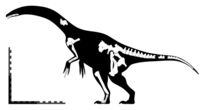Wikipedia:Today's featured article/April 12, 2020
Segnosaurus is a genus of large-bodied therizinosaurid dinosaurs that lived during the Late Cretaceous period. Discovered in the Gobi Desert in southeastern Mongolia in the 1970s, incomplete but well-preserved specimens included the lower jaw, neck and tail vertebrae, the pelvis, the shoulder girdle, and limb bones. Parts of the specimens have since gone missing or become damaged. Named in 1979, Segnosaurus ('slow lizard') is estimated to have been about 6–7 m (20–23 ft) long and to have weighed about 1.3 metric tons (1.4 short tons). It was bipedal, with the trunk of its body tilted upwards. The head was small with a beak at the tip of the jaws, and the neck was long and slender, adapted to browsing. The forelimbs were robust, with three-fingered hands bearing large claws, and the feet had four toes. The pubic bone was turned backwards, as in birds. Segnosaurus and its relatives are thought to have been mainly herbivorous, unlike most other theropods, and slow-moving. (Full article...)

